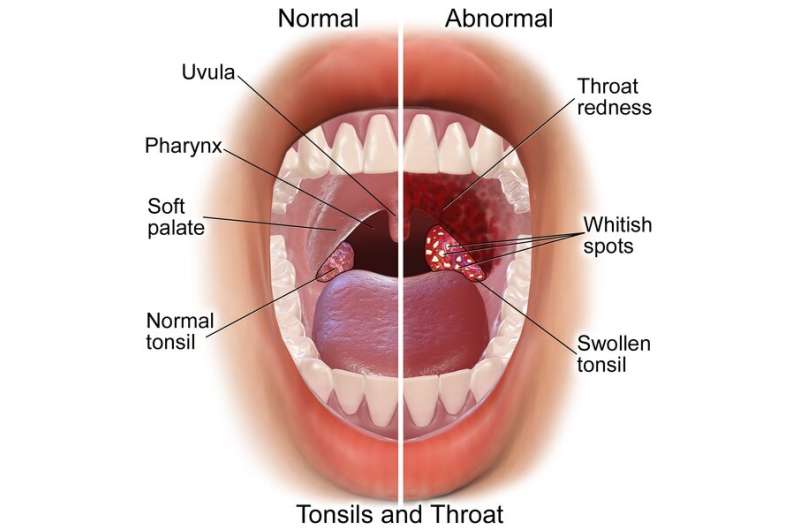Tonsils. Credit: Wikimedia Commons, CC BY 3.0
Researchers led by a team at UT Southwestern Medical Center have created a statistical model to identify standards for typical, high, or low rates of bleeding after pediatric tonsillectomies. The findings, published in JAMA Otolaryngology-Head & Neck Surgery, could help doctors and hospitals improve outcomes for the third-most common pediatric surgery in the U.S.
"This model is a useful instrument to include in quality and safety initiatives around tonsillectomies. Now, doctors have a validated model to judge their bleeding rates against," said first author Romaine Johnson, M.D., Professor of Otolaryngology-Head and Neck Surgery at UTSW and the Department's Director of Quality and Safety.
In 2019, the American Academy of Otolaryngology-Head and Neck Surgery Foundation issued updated guidelines for pediatric tonsillectomies, which recommended that surgeons self-monitor their patients' bleeding rates after these procedures. Ron Mitchell, M.D., UTSW Professor of Otolaryngology-Head and Neck Surgery and Chief of Pediatric Otolaryngology, was lead author on those guidelines and on the current study.
Although complications after tonsillectomies are rare, Dr. Johnson said, excessive bleeding is one of the most common and is often considered a factor in the very few deaths associated with this surgery. The change in guidelines was a significant step toward helping improve tonsillectomy safety, he said, but physicians faced a significant hurdle in using them effectively. No standards existed to inform doctors whether their personal or institutional bleeding rates were considered normal, high, or low.
To develop probability standards, Dr. Johnson and his colleagues collected data from the Children's Hospital Association's Pediatric Health Information System database, which contains de-identified patient information covering inpatient stays, outpatient surgeries, emergency department visits, and observation unit patient data from more than 49 not-for-profit children's hospitals in the U.S.
The researchers were primarily interested in data involving patients who came to the emergency department or were readmitted for bleeding after tonsillectomies—a sign that their bleeding after the procedure was considered excessive. Researchers collected demographic data on these patients as well as medical histories.
After stratifying bleeding rates for these institutions into percentiles, the team found that the median probability rate for bleeding among all patients was 1.97%. The lowest rate hovered just over 1%, and the highest rate, in the 99th percentile, was 6.4%. Variables associated with increased rates of post-tonsillectomy bleeding included adolescent age (older than 12), Hispanic ethnicity, residence in a relatively high-wealth ZIP code, and obesity.
Dr. Johnson emphasized that the study did not account for surgical technique or the many tools available to perform tonsillectomies. Different training of surgeons could also affect results, a variable that's difficult to capture, he said. But Dr. Johnson stressed that technique may not be to blame for higher bleeding rates since many factors outside a surgeon's control contribute to risk, including a patient's age or other comorbidities.
"This model provides a useful starting point to help surgeons look critically at their own bleeding rates and help them understand why this complication might occur," Dr. Johnson said.
More information: Romaine F. Johnson et al, Estimated Probability Distribution of Bleeding After Pediatric Tonsillectomy, JAMA Otolaryngology–Head & Neck Surgery (2023). DOI: 10.1001/jamaoto.2023.0268
Journal information: JAMA Otolaryngology–Head & Neck Surgery
Provided by UT Southwestern Medical Center























